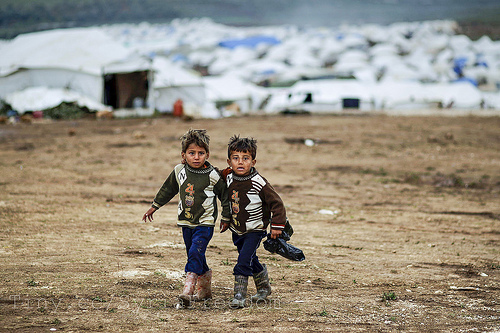 The UN High Commissioner for Refugees released a report entitled The Future of Syria – Refugee Children in Crisis detailing the conditions under which these children live. The Syrian conflict, which began in March 2011, has forced more than 1.1 million children to flee their homes and seek asylum as refugees. These children experience physical and psychological wounds as a consequence of the horrors they have been subjected to both in Syria and in refugee camps.
The UN High Commissioner for Refugees released a report entitled The Future of Syria – Refugee Children in Crisis detailing the conditions under which these children live. The Syrian conflict, which began in March 2011, has forced more than 1.1 million children to flee their homes and seek asylum as refugees. These children experience physical and psychological wounds as a consequence of the horrors they have been subjected to both in Syria and in refugee camps.
These children are struggling to survive under extremely dangerous and stressful conditions. Documentation shows that over 11,400 children under the age of 17 have been killed as a direct consequence of the conflict. Children that survive the violence tearing apart their nation do not escape unscathed. They often carry with them physical scars or psychological symptoms of distress such as sleeplessness, stress, PTSD, and emotional upset.
“Bombed in their homes, in their communities, during day-to-day activities such as waiting in bread lines or attending school. Shot by bullets in crossfire, targeted by snipers, summarily executed, even gassed and tortured,” is how Hana Salama, who co-authored the report Stolen Futures – the Hidden Toll of Child Casualties in Syria, described the lives of children living in Syria.
Children who escape the conflict continue to suffer as refugees. In refugee camps, they live in overcrowded quarters and struggle to secure basic necessities like food and water. Refugee families depend upon humanitarian aid for all of their necessities, but it is becoming increasingly difficult for host nations to provide for the large number of refugees in need of assistance.
These conditions have created a tense environment where refugees live with a constant sense of insecurity and isolation. Violence within the camps also poses a constant danger, especially for women and children. Domestic violence, sexual exploitation and rape are realities of life for many of these refugees.
“If we do not act quickly, a generation of innocents will become lasting casualties of an appalling war,” declared High Commissioner for Refugees.
Children are further burdened with providing their families with an income since most adults living in camps have little to no income due to a lack of employment opportunities. Consequently, half of all refugee households end up depending upon children to provide for the family. This responsibility places a heavy strain upon already traumatized children, keeps them out of school and also exposes them to dangerous and exploitative working conditions.
A child refugee living in Jordan exclaimed, “our lives are destroyed. We are not being educated, and without education there is nothing. We’re heading towards destruction.”
Even though many parents and children value education, it has become a luxury that many refugees cannot afford. Children fail to enroll in school not only because of employment, but also because education is not readily accessible. Students face high costs of supplies, excessive distance to schools, teaching in unfamiliar languages and limited space available at schools. These conditions have resulted in increasing numbers of refugee children being left without access to an education.
Creative Commons Love: Freedom House on Flickr.com
Written by Amanda Lubit